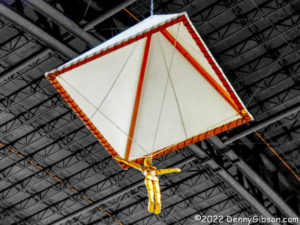 I’ve read that, once upon a time, ordinary people rarely needed to count past forty and that forty became another way of saying “a whole bunch”. That implies that Noah and family might not have watched it rain for precisely forty days and nights and that Ali Baba may not have encountered exactly forty bad guys. We have outgrown that, of course, and today use numbers like gazillion when we are tired of counting even though that probably occurs long before we reach forty. That is not, however, the case with this post. The Leonardo da Vinci: Machines in Motion exhibit currently at the National Museum of the Air Force in Dayton contains exactly forty of Leo’s “machines”.
I’ve read that, once upon a time, ordinary people rarely needed to count past forty and that forty became another way of saying “a whole bunch”. That implies that Noah and family might not have watched it rain for precisely forty days and nights and that Ali Baba may not have encountered exactly forty bad guys. We have outgrown that, of course, and today use numbers like gazillion when we are tired of counting even though that probably occurs long before we reach forty. That is not, however, the case with this post. The Leonardo da Vinci: Machines in Motion exhibit currently at the National Museum of the Air Force in Dayton contains exactly forty of Leo’s “machines”.
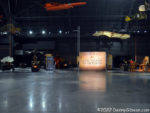 I took in the exhibit on Friday. It is set against the wall farthest from the entrance which means there is some walking involved. Not only does this provide an opportunity for a little exercise, but there are also plenty of opportunities for getting distracted on the way by the many other, mostly permanent, displays in this wonderful museum. I skipped my favorite gallery, Early Years, and focused on the da Vinci exhibit and still spent at least as much time getting to and from it as I did experiencing it. It’s simply impossible to ignore all those unusual planes and their engaging stories.
I took in the exhibit on Friday. It is set against the wall farthest from the entrance which means there is some walking involved. Not only does this provide an opportunity for a little exercise, but there are also plenty of opportunities for getting distracted on the way by the many other, mostly permanent, displays in this wonderful museum. I skipped my favorite gallery, Early Years, and focused on the da Vinci exhibit and still spent at least as much time getting to and from it as I did experiencing it. It’s simply impossible to ignore all those unusual planes and their engaging stories.
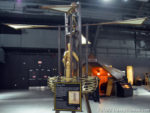
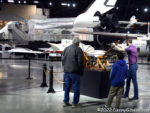 A fair number of the displayed machines have to do with flight. That is certainly appropriate for the Air Force Museum although the exhibit’s makeup was not tuned for the location. In fact, this appearance seems to be a recent addition that is not yet listed on the schedule at the Machines in Motion website.
A fair number of the displayed machines have to do with flight. That is certainly appropriate for the Air Force Museum although the exhibit’s makeup was not tuned for the location. In fact, this appearance seems to be a recent addition that is not yet listed on the schedule at the Machines in Motion website.
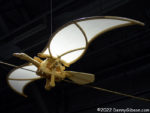
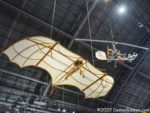
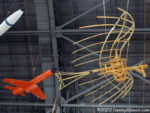 The high ceiling at the museum allows some of da Vinci’s concepts to be suspended overhead as if in flight although they sometimes have to share space with flying things of more recent vintage. The overhead displays include the “parachute” in the opening photograph. The version here is not quite full size. A full-sized version and a description of a real-world use of the design were part of the Da Vinci the Genius exhibit I saw in Cincinnati in 2016.
The high ceiling at the museum allows some of da Vinci’s concepts to be suspended overhead as if in flight although they sometimes have to share space with flying things of more recent vintage. The overhead displays include the “parachute” in the opening photograph. The version here is not quite full size. A full-sized version and a description of a real-world use of the design were part of the Da Vinci the Genius exhibit I saw in Cincinnati in 2016.
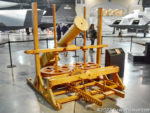
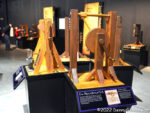
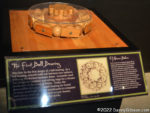 Leonardo’s flying machines may not have been practical but many of his other ideas certainly were. I don’t believe it is a proven fact that he invented ball bearings but his design of a revolving stage using them might have been their first practical application. His designs for converting one form of motion to another (e.g., rotary to linear) were definitely practical. Check out the kid getting a real hands on education in the background of the second picture. The third picture shows a machine combining several devices to raise heavy pillars.
Leonardo’s flying machines may not have been practical but many of his other ideas certainly were. I don’t believe it is a proven fact that he invented ball bearings but his design of a revolving stage using them might have been their first practical application. His designs for converting one form of motion to another (e.g., rotary to linear) were definitely practical. Check out the kid getting a real hands on education in the background of the second picture. The third picture shows a machine combining several devices to raise heavy pillars.
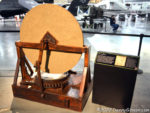 Seeing this machine for grinding concave mirrors was a real learning experience for me. The sign next to it talks about burning mirrors and mentions that one of their uses was welding. Believing that welding was at best an eighteenth-century concept, I had to look into that and discovered that the welding of soft metals like gold and copper goes back much further and was rather common in da Vinci’s day.
Seeing this machine for grinding concave mirrors was a real learning experience for me. The sign next to it talks about burning mirrors and mentions that one of their uses was welding. Believing that welding was at best an eighteenth-century concept, I had to look into that and discovered that the welding of soft metals like gold and copper goes back much further and was rather common in da Vinci’s day.
The exhibit runs through May 8 and, like the museum itself, is free.
